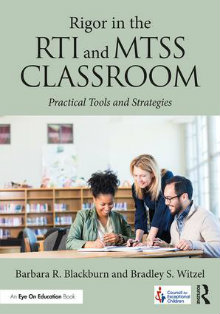Practical Tools for RTI and MTSS Classrooms
Rigor in the RTI and MTSS Classroom: Practical Tools and Strategies
By Barbara R. Blackburn and Bradley S. Witzel
(Routledge, 2018 – Learn more)
Reviewed by Bryndle Bottoms
 Rigor in the RTI and MTSS Classroom is rich with useful tools and methods to effectively teach all children. The book encourages the whole school approach with specifics on leadership teams that are trained in areas of MTSS. It offers an excellent example of how to expand a current MTSS program in a school or how to start a new one.
Rigor in the RTI and MTSS Classroom is rich with useful tools and methods to effectively teach all children. The book encourages the whole school approach with specifics on leadership teams that are trained in areas of MTSS. It offers an excellent example of how to expand a current MTSS program in a school or how to start a new one.
The text is a starting point for those educators who need knowledge on MTSS supports. For those educators who have been trained in MTSS, there are additional tools that can be used to expand best practice in classrooms across America.
 The book opens with an explanation of how rigor, RTI and MTSS should go hand in hand. The authors attribute its need to two main factors: the current school dropout rate and the skill set required to be a functioning member of society.
The book opens with an explanation of how rigor, RTI and MTSS should go hand in hand. The authors attribute its need to two main factors: the current school dropout rate and the skill set required to be a functioning member of society.
It is known that “students with learning disabilities make up 62% of secondary students with disabilities, and 21% of students with learning disabilities drop out of high school” (p. 2). In addition, the most desired skill for college graduates is the ability to solve problems and make decisions.
The book’s introduction explains the differences in RTI and MTSS. RTI focuses on the interventions used in the classroom, and MTSS focuses on the core instruction that is provided to all students to prevent learning difficulties.
Chapter 1: “Rigor and the RTI/MTSS Classroom.” The chapter discusses how more rigor is needed in classrooms because it will ensure that students are prepared for life after high school and/or college. Educators should move from a purely standards focused approach to allowing students to secure foundation knowledge and apply that knowledge to problems within and outside the classroom.
Rigor, the authors tell us, does not mean students are doing more work but that the quality of the assignment requires more rigor. Strong expectations, support of instructional decisions, and a demonstration of learning ensures rigor.
Chapter 2: “Tiered Instruction.” Students are held to expectations that are obtainable but are given support based on varying needs of assistance. There are three tiers; core instruction, tier 2 and tier 3. In a tiered system, educators use data from progress monitoring tools to determine eligibility and modify instruction. The various tiers do not lower expectations for students; instead they ensure that students are held to a rigorous standard.
Chapter 3: “Prevention, then Intervention.” This chapter emphasizes a change in focus. Instead of educators making what the student is doing wrong the primary focus, educators search for ways to adjust instruction to help the student improve. Students should be expected to achieve at a certain level of rigor, and educators are to assist the students to reach that goal. If the students are given rigor and strong core instruction, then the interventions at tier 2 or 3 will be more effective.
Chapter 4: “Evidence-Based Instructional Strategies.” This chapter discusses general and specific recommendations for educators to use to instruct students. Each of the recommendations is backed by previous research. General recommendations include teacher clarity, on-task classroom discussions, self-questioning, direct instruction and explicit, systematic instruction.
The chapter outlines appropriate feedback and non-linguistic representations of knowledge. Finally, mathematical strategies are discussed and examples are given for modeling, verbalizing thought processes, guided practice and cumulative reviews.
Chapter 5: “Evidence-Based Practices in Literacy.” This chapter analyzes strategies to assist students with reading and writing skills. The methods described are research based and recommend having students write about what they are reading, including direct teaching of writing skills, and supporting students to write summaries and notes.
The authors emphasize that teachers should incorporate writing into all subject areas. They also note a need for differentiation; this can be done with interest groups to encourage specific learner’s interests and by giving a choice to students when it comes to reading.
Chapter 4 and 5 are quite rich in their descriptions of evidence based practices, are reader friendly, and describe techniques that can be implemented quickly.
Chapter 6: “Rigorous Assessment in the RTI/MTSS Classroom.” This chapter goes into detail about the backbones of this process. The goal of MTSS is to hold each student to a high, but obtainable, standard; this standard can only be determined through the use of assessments.
A general screening cannot determine need for interventions; therefore other assessments are necessary. Diagnostic assessments can include task analysis, running records, and short progress monitoring probes. Benchmark assessments determine if the work done through the intervention is generalizing for the learner to other areas of academia. The intervention analysis of all of these data points is the key to determine how well a learner is advancing.
Chapter 7: “Behavior and Social and Emotional Learning through RTI/MTSS.” The chapter emphasizes the range of behaviors that are often seen and gives ways to support learners through positive behavior intervention support (PBIS) and social emotional learning (SEL).
PBIS emphasizes a proactive mindset towards a positive school climate and appropriate tiered behavior supports. This system also includes self-monitoring for learners and praise. SEL results in fewer discipline problems, higher student achievement, and increased academic success.
Chapter 8: “Working Together: The RTI/MTSS Leadership Team.” The text points out that if a strong leadership team is not in place, then the MTSS supports will not work. The authors emphasize collaboration and shared decision making.
The interventionist role and early intervention training are specifically discussed. It is impossible for someone with minimal training to effectively give interventions. This is of key importance and is a valid, rich point but not a practice often followed in school districts across the country. This chapter lays out specifics on how to lead the MTSS team in a very comprehensive way and includes many charts and timelines for planning.
Bryndle L. Bottoms is a doctoral student at the University of North Carolina at Charlotte. She has expertise in early childhood teaching, multi-tiered systems of support, and early numeracy skills with diverse learners. She is furthering her education with a doctorate in Educational Research, Measurement and Evaluation to prepare pre-service teachers to adequately use research based practices in their own classrooms.

































